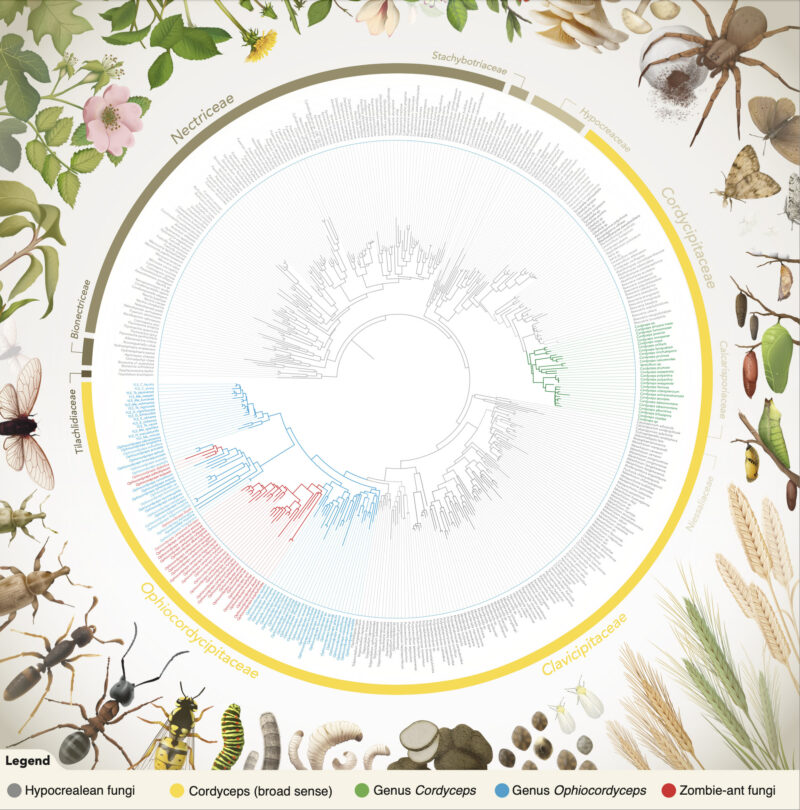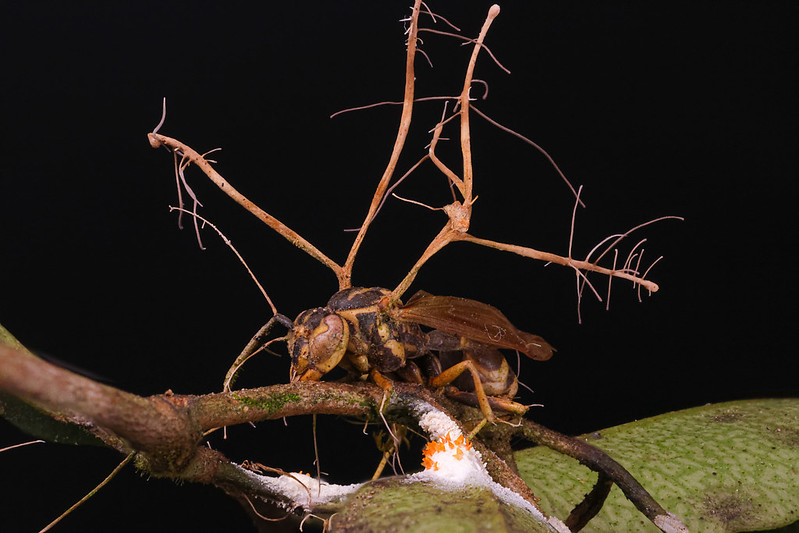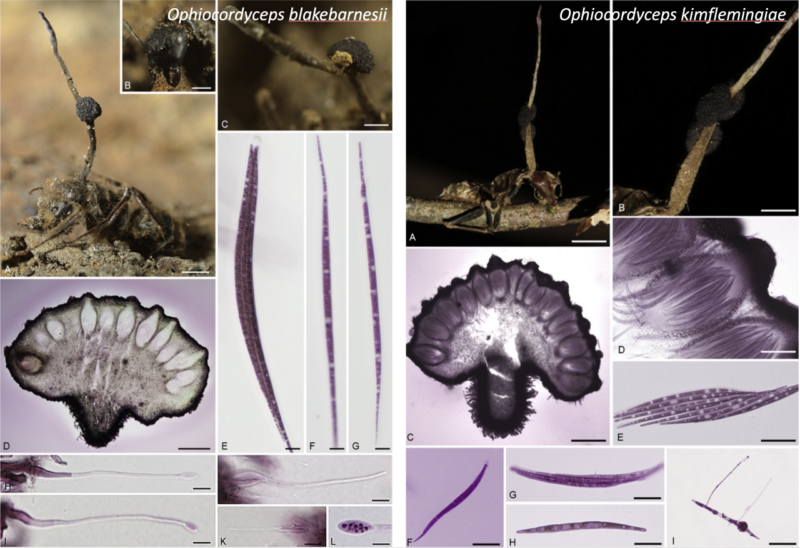Not the Last of Us: The Truth about Zombie Fungi
HBO’s new series The Last of Us has drawn millions of viewers and generated considerable buzz since its release in mid-January. Based on a 2013 video game, the show is set 20 years after a global pandemic sparked by a mass fungal infection that transforms people into zombie-like creatures. The plot follows Joel (played by Pedro Pascal) and the teenage Ellie (Bella Ramsey) as they struggle to survive in the post-apocalyptic setting. The fictional fungus, which is based on real-life species that infect ants, is referred to in The Last of Us as “Cordyceps.”
That is the name of a group of actual fungi, but where is the line between fact and fancy? NYBG has the answers and is here to set the record straight. Our Assistant Curator of Mycology, Dr. João Araújo, has been asked by many news outlets—including Forbes, National Geographic, and CNN—to discuss the zombifying fungus. However, he says that there are still common misconceptions attached to these fungi, which he’d like to clear up.
Read on to hear from Dr. Araújo.
Facts about Cordyceps fungi
Entomopathogenic fungi, popularly known as “Cordyceps fungi,” have intrigued naturalists such as Alfred Russell Wallace since the 1860s. Since then, only a few scientists have dedicated their careers to understanding these fascinating organisms, which has led to an immense knowledge-gap about the true diversity and evolutionary history of these fungi.

Fig. 1—Round phylogeny of the fungal order Hypocreales (grey). The “Cordyceps fungi” in a broader sense comprises all species within the yellow outer ring. The genus Cordyceps is shown in green, the genus Ophiocordyceps in blue and the “zombie-ant fungi” species in red (within Ophiocordyceps). This figure does not reflect all the species known for these fungal groups, but a representation of the diversity of hypocrealean fungi. The organisms around the tree reflect the major host groups parasitized by the fungal groups in front of them.
Credit: Mark Belan and João Araújo
However, in recent years and notably in the last few weeks, the intriguing biology of some “Cordyceps fungi,” which have the ability to manipulate the host behavior to make them real-life zombies, has been a source of fascination and even some concern in the broad public, especially since the debut of The Last of Us. The show is set in a dystopic context where these “Cordyceps fungi” have switched from infecting and manipulating moribund ants to infecting and zombifying humans—a pretty scary story, especially in the context of the ongoing COVID-19 pandemic and its consequences.
But what are the major misconceptions and fictional, non-scientifically accurate aspects attributed to these fungi? There are several articles out there about why it is unlikely that Cordyceps fungi would jump from ants to become a human pathogen. But there are some aspects of this story that are not being told.
Point 1: Not all fungi commonly referred to as “Cordyceps” manipulate their host behavior. The species that exhibit the “zombification abilities” belong to the genus Ophiocordyceps.
The first misconception is that, scientifically speaking, there is no evidence that Cordyceps species can control the host behavior. “What?”—people might think—“We have been bombarded by video games, TV shows and documentaries saying Cordyceps can control the host behavior, so is it not true?” To answer this question, we need to provide some scientific background on these fungi.

Fig. 2—Ophiocordyceps humbertii infecting wasp and white unknown fungus infecting a scale insect
Until 2007, most of the filamentous fungi that infect insects and produce a fruiting body (similar to a mushroom) would be categorized as “Cordyceps fungi.” However, molecular studies have shown that these “Cordyceps fungi” are actually composed of several fungal lineages that evolved the ability to infect insects independently along the evolution of the kingdom Fungi. Scientists call these lineages “monophyletic groups,” meaning that each group shares one common ancestor and represents a unique branch in the Fungal Tree of Life.
Therefore, these molecular studies combined with morphological and ecological observations have provided convincing data to reorganize “Cordyceps fungi” into three fungal families (Cordycipitaceae, Clavicipitaceae and Ophiocordycipitaceae), which reflects its evolutionary history (Fig. 1). The family Cordycipitaceae includes several fungal genera, mostly insect parasites, including the genus Cordyceps (in italics since this refers to a formal taxonomic group). The family Ophiocordycipitaceae includes other monophyletic groups (genera), including Ophiocordyceps unilateralis group, that embraces most species of the “zombie-ant fungi.” Hence, the fungal group that has the ability to infect and turn the hosts into zombies (marked in red, Fig. 1) are species within the Ophiocordyceps genus (marked in blue), not “the true” Cordyceps (marked in green).
But, for the sake of simplicity and to take advantage of a widely and relatively well-known term, we currently accept still referring popularly to all these fungi as “Cordyceps”. The latter not in italics, meaning it refers to the traditionally used term referring to a collective of entomopathogenic species—represented by the species within the yellow ring in the Figure 1—and not only the genus Cordyceps (in italics), which is represented as the green branches in the phylogenetic tree in Fig. 1.
Point 2: There are many species of zombie-ant fungi, which are all within Ophiocordyceps. There may also be many more that have not yet been discovered.
“Cordyceps, the zombie-ant fungus” is treated like a single species in The Last of Us, since there is no mention of multiple lineages and different types of infection and manipulation strategies we see in the real-life infections. The genus Ophiocordyceps, which includes all the “zombie-ant fungi” species, currently comprises approximately 320 species. Among those, approximately 35 are able to manipulate the ant’s behavior, predominantly carpenter ant species. The “zombifying fungi” are very strict regarding the species they infect, as one particular species of Ophiocordyceps fungus can only infect one particular species of ant. However, based on our extensive surveys across the globe we know there are many more than 35 species able to zombify their hosts and the vast majority of those are still waiting to be described worldwide. Our preliminary data has shown that over 50% of the carpenter ant species are infected by a unique species of Ophiocordyceps fungus in the Brazilian Amazon. Each of these ant species is infected by “its own fungal species”. Therefore, if we extrapolate that number to the global diversity of carpenter ants, which is close to 1,200 species, and apply the (conservative) rate of 50% of ant species infected, we can estimate a global number of 600 species of “zombie-ant fungus” yet to be described. Currently, we can only see the tip of the iceberg, but we expect to explore and unravel dozens of new species and likely, novel types of behavior manipulation (zombification), in the next few years.

Fig. 3—Ophiocordyceps blakebarnesii and Ophiocordyceps kimflemingiae
Point 3: Species within Ophiocordyceps are found across the globe.
The third misconception is that zombie-ant fungi are obscure organisms that are only found in remote areas or deep in the tropical forests. This is not true. In addition to the species we had to indeed explore deep in the forests we have discovered and described new species based on specimens collected by community scientists across the globe. For example, in the United States, there are two examples, Ophiocordyceps kimflemingiae and Ophiocordyceps blakebarnesii. Kim Fleming found that her own backyard in South Carolina was a hotspot with hundreds of zombie-ant fungi that could be observed and collected year after year.
A few years later, Blake Barnes from Missouri got in contact with our lab with photos of another undescribed species of the zombie-fungus. In this case, the fungus manipulated the ants to die inside logs in forests near his house. That unique type of manipulation is likely to provide protection from the cold weather, contrasting with the usual leaf-biting behavior displayed by tropical species. Upon closer look, and through morphological and genetic analyses, we confirmed that Blake’s finding was indeed a new species. Both these species were named after Kim and Blake, who actually discovered them. Recently, when I was living in Gainesville, Florida, I found an Ophiocordyceps camponoti-floridani in my own backyard, which I had described years ago from another part of Florida, growing out of a carpenter ant’s head (Camponotus floridanus), which was biting onto a palm leaf.
Maybe, if you look closely, you will be able to find these zombie-ants hanging on a plant in your backyard or in a forest area near you. One thing is true: we are surrounded by real-life zombies!
SUBSCRIBE
Enter your email address to subscribe to this blog and receive updates on new posts.











